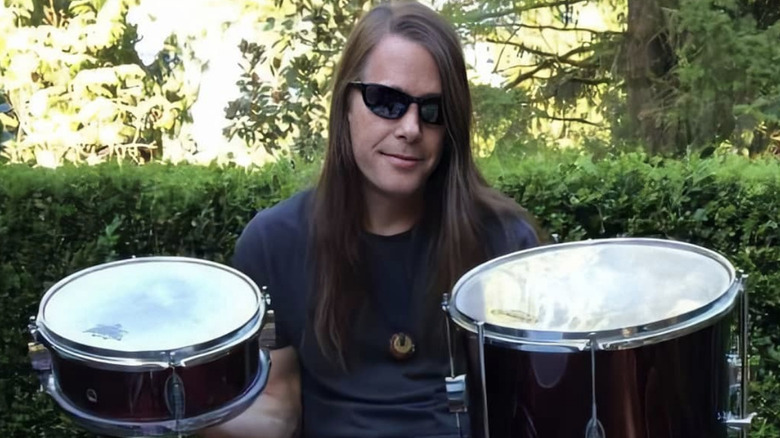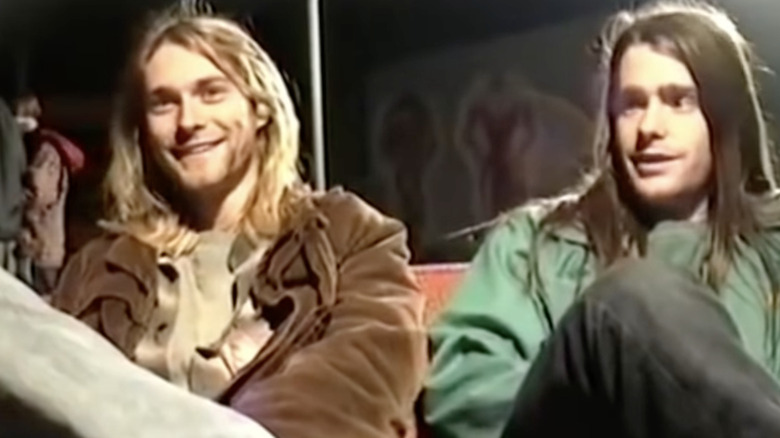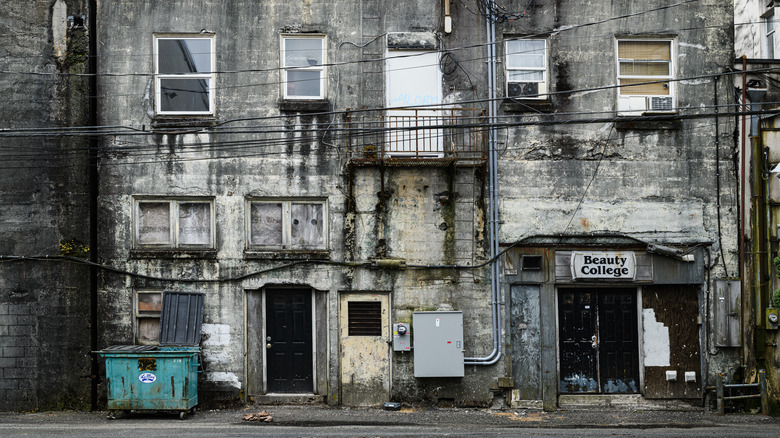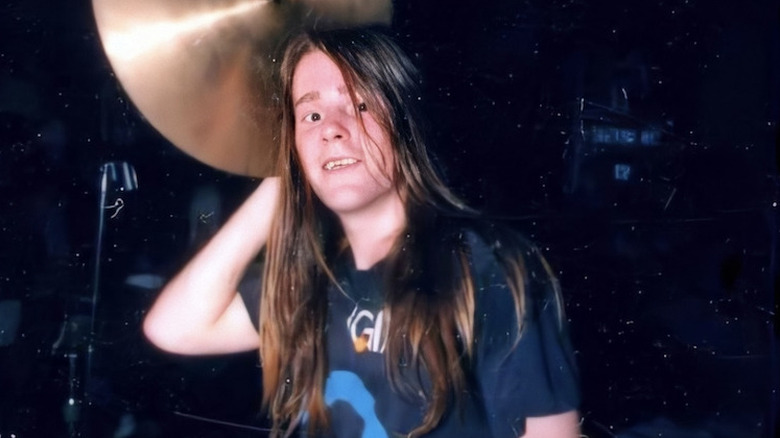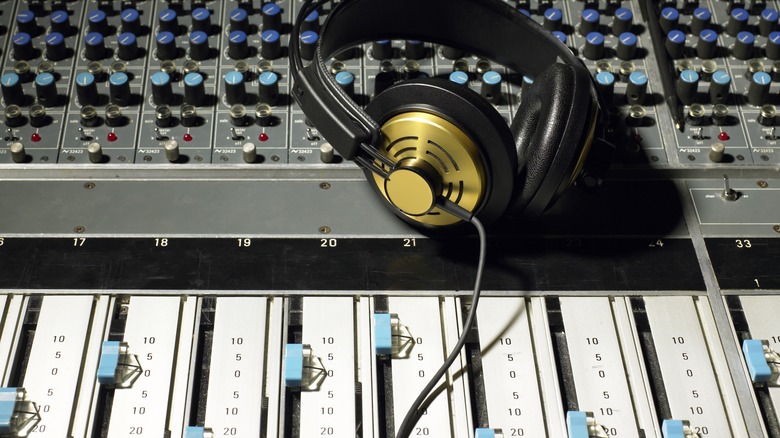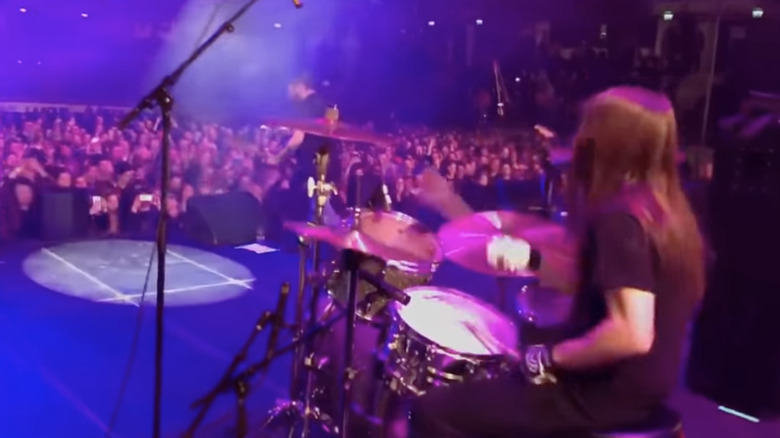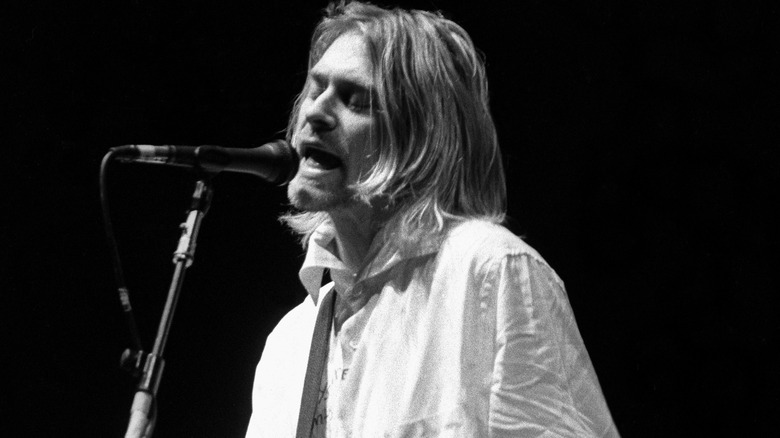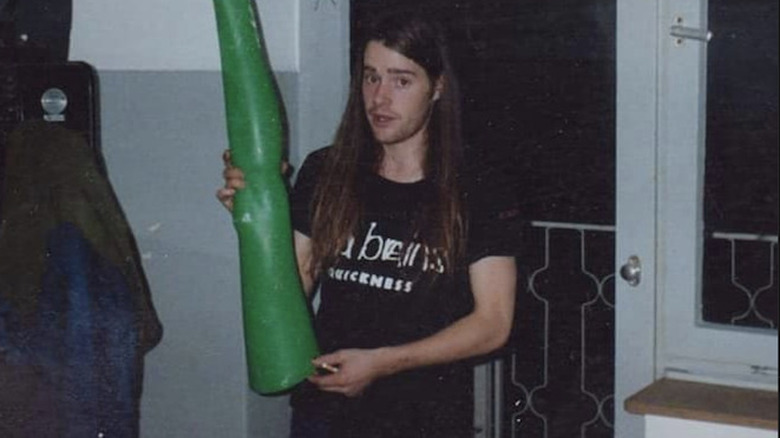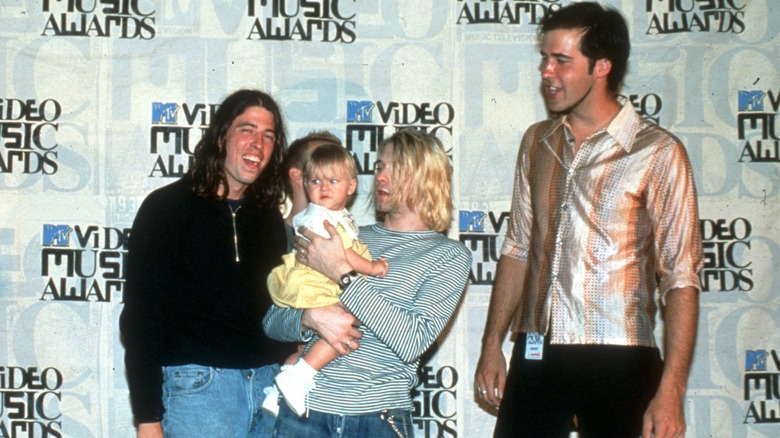The Story Of Chad Channing's Time In Nirvana
In a way, Chad Channing is the Pete Best of Nirvana: the drummer who played for the band right before they got someone else and became massive rock stars. Much like Best played the drums for the Beatles on their pre-fame recordings, Channing kept time for the would-be grunge icons as they evolved from average, everyday garage band to local sensations. And that's him you're hearing banging away on the drums on most of the songs featured in Nirvana's 1989 debut album "Bleach." That album only peaked at No. 89 on the Billboard 200, but it drew a lot of attention years after the fact from rock fans who wanted to know how the band sounded like before Dave Grohl took over as their final and definitive drummer.
There's been a lot that's been said and written about Nirvana from the time "Nevermind" — and the single "Smells Like Teen Spirit" — took over the airwaves and transformed Seattle into the world's capital of rock music for most of the early '90s. But the band's history with Channing can sometimes be overlooked, and it happens to be an interesting one that started with him stepping into what was then a revolving door for drummers.
Chad Channing was Nirvana's fifth drummer
Before Chad Channing joined Nirvana, there were four individuals who played drums for the band, dating back to the time it was an unnamed project featuring Kurt Cobain and Krist Novoselic. Bob McFadden was technically the first, and he was followed by Aaron Burckhard and Dave Foster. Melvins' drummer Dale Crover recorded some songs with Nirvana but was never a full-time member.
Indeed, it seemed as if the yet-to-be-famous Nirvana was changing drummers a la Spinal Tap, as nobody seemed to stick around for more than a few months. After an ad they put out on Seattle rock publication The Rocket failed to attract anyone of note, Cobain and Novoselic were introduced to Channing by a mutual friend. Initially unsure whether he wanted to join, Channing eventually agreed after watching one of Nirvana's final shows with Foster on drums.
Born on January 31, 1967, in Santa Rosa, California, Channing lived a nomadic childhood and turned to music in his early teens after a serious injury shattered his potential as a young soccer player. At the time he joined Nirvana, he was living in the Washington suburb of Bainbridge Island and was fresh off a stint with a band called Tic-Dolly-Row, which also featured would-be Soundgarden bassist Ben Shepherd on lead vocals. Add that to the fact he was a multi-instrumentalist and had a pretty solid resume as an up-and-coming musician.
Channing never got a formal invitation to join Nirvana
Back when Nirvana was known as Bliss (one of many short-term band names they used in the early years) and Chad Channing had just heard of them for the first time, his would-be bandmates were mystified by his elaborate drum kit, as he revealed in an interview with Michael Azerrad for his Nirvana biography, "Come As You Are: The Story of Nirvana."
"They noticed my North kit," Channing told Azerrad. "It was kind of loud and that's what they hit on there. I remember Kurt telling me a long time ago when they were first checking us out, 'God, man, I wish we could get that guy! Look at those drums! Those are the weirdest things I've ever f***in' seen!"
As further noted in "Come as You Are," Channing was never formally extended an invitation to join Nirvana; he just kept showing up to multiple rehearsals until it was understood between both sides that he was Nirvana's new permanent drummer. After Kurt Cobain and Krist Novoselic forced Channing to downsize his drum kit to a more minimalist setup, the threesome rehearsed old songs and new ones alike on a regular basis, and in May 1988, Channing played his first official show as a member of Nirvana.
An unusual early bonding experience with his new bandmates
While it may have seemed strange that Chad Channing never got as much as a verbal "hey, you're in the band" acknowledgment from his new bandmates, that paled in comparison to what happened after one of his first rehearsals with the group.
According to Charles R. Cross' "Heavier Than Heaven: A Biography of Kurt Cobain," Channing was given a tour of various spots in Nirvana's then-home base of Aberdeen, Washington, following one practice session. Things took a turn for the bizarre when Channing, Kurt Cobain, and Krist Novoselic made their way to an allegedly haunted house in the woods nicknamed "the Castle."
As the band drove to the property, Cobain tried to scare Channing by telling him stories of people entering the house, never to return. Originally, the plan was for Cobain and Novoselic to enter the house, but the two Nirvana founders found themselves too scared to set foot in it, even as Channing encouraged them to do so. For his part, Channing thought this was some sort of hazing ritual, and he was all ready to go in ... before he realized Cobain was genuinely afraid, having seemingly bought into his own tall tales of scary clown paintings and people dying in the house. Ultimately, nobody entered the purportedly haunted property, but as Cross detailed, this was Channing's real introduction to Cobain's complicated personality.
He played drums on Nirvana's first Sub Pop release
With Chad Channing now established as Nirvana's new drummer, the band caught the attention of Sub Pop, a Seattle-based independent label run by Bruce Pavitt and Jonathan Poneman. As detailed in "Heavier Than Heaven," Pavitt and Poneman agreed to let Nirvana record a single for their label after watching one of their June 1988 shows, with recording sessions commencing shortly thereafter. Over a span of 13 hours and three sessions in June and July, Nirvana recorded four tracks, including a cover of the Dutch band Shocking Blue's song, "Love Buzz." The latter song had become a highlight of the band's live performances, and it was a natural choice for their first-ever single. When "Love Buzz" finally dropped in November 1988, it sold out its initial pressing of 1,000 copies.
Apart from the fact that Channing was behind the drum kit as Nirvana recorded their first single, the recording process proved to be a good learning experience for the young musicians. Speaking to Pitchfork in 2008, Pavitt recalled advising them to shorten the 45-second montage that kicked off the single, as waiting too long for the actual music to start could cause listeners to tune out. "If you're an unknown band from Aberdeen, Washington, you're lucky if they even put the needle on the record, period," he said. "So I strongly suggested that [Cobain] cut down the intro to 10 seconds or something like that."
Long drives to practice brought the band closer
Chad Channing had a whole lot of traveling to do so he could rehearse with Nirvana, and the fact he lived in Bainbridge Island and took the ferry to Seattle was just part of it. The other two members also had to make their share of sacrifices. For starters, Aberdeen resident Krist Novoselic would drive his van to pick up Kurt Cobain, who was living in Olympia in late 1988. The two would then meet Channing in Seattle before driving back to Aberdeen for just three hours of practice time.
If you're bummed out by all the driving you need to do to meet up with bandmates living far away, consider that Nirvana's route would sometimes cover 400 miles. But spending so much time together on the road did have its advantages, as Charles R. Cross pointed out in "Heavier than Heaven" — the band members grew closer to each other, and the eclectic mix of music they listened to on their route helped broaden their influences. "We listened to Mudhoney, Tad, Coffin Break, the Pixies, and the Sugarcubes," Channing told Cross, naming three Seattle scene contemporaries along with one of the most influential alternative rock bands of all time, as well as the group that got Björk her first international recognition.
Channing's role in the making of Bleach
From December 1988 to January 1989, Kurt Cobain, Krist Novoselic, and Chad Channing entered the studio with producer Jack Endino and recorded nine tracks that would make up Nirvana's first album, with the other three songs being remixed versions of demos Cobain and Novoselic cut with the Melvins' Dale Crover on drums. The Beatles-inspired "About a Girl" is arguably the best-known track to come out of "Bleach," and Channing happened to play a small, but important role in the song's creation.
Speaking to Novoselic in a 2009 Seattle Weekly interview conducted by the Nirvana bassist, Channing revealed that he was the one who encouraged Cobain to go with the song's simple, straightforward title. "The song didn't have a title by that time, so I asked Kurt, 'What is that song about?' He said 'About a girl.' I said 'Why don't you just call it that?' So he made this quirky smile and said 'OK!,'" he shared.
Channing also talked about the recording process itself, explaining how Endino resorted to some unorthodox techniques to enhance the drum sound, which was a challenge considering Nirvana's preference for detuned guitars. "The drum heads were really loose, and it was kind of hard to play because you didn't get that snap-back," he said. "Jack Endino taped a coin to the kick-drum head so it would have a brighter tone."
Channing recommended Jason Everman as Nirvana's second guitarist
For most of its existence, Nirvana was a three-piece band. But for a few months in 1989, the group operated as a four-piece, having added a second guitarist, Jason Everman, (pictured, third from left) that spring. He and Chad Channing were childhood friends and former bandmates, and it was the drummer himself who recommended his old buddy when Nirvana started considering adding another axeman.
Aside from footing the recording bill for "Bleach," Everman's most prominent role in Nirvana came in the summer of 1989 as the band went on their first major U.S. tour. Some of the shows on that tour were so poorly attended that it would only be the other bands who'd be watching, but according to Channing, the most important thing for this four-piece configuration of Nirvana was the response of the crowd and not its size. "A lot of people would say they liked us," he was quoted as saying in "Heavier Than Heaven."
Unfortunately, things began to sour between Everman and his bandmates toward the end of the tour. In 2013, Channing told The New York Times Magazine that it was hard to figure out why his longtime friend was suddenly bummed out. "He doesn't talk freely when things are bothering him," he said. Cobain and Krist Novoselic reached their breaking point with Everman when he brought home a groupie after a gig in Massachusetts. He was fired at the end of the tour.
Channing opened up about Nirvana's growing buzz during their 1989 European tour
Nirvana kept gaining momentum despite Jason Everman's awkward exit, and they were back in the studio in August 1989, this time with Steve Fisk as producer. With the exception of "Polly," none of the songs recorded during those sessions made it on any subsequent studio album, and most of them dealt with Kurt Cobain's rocky relationship with his father, Don. Compared to the rawness of "Bleach," the Fisk tracks had a "big Top 40 drum sound," the frontman was quoted as saying in "Heavier Than Heaven."
Up next for the band was a tour of Europe that also included Sub Pop labelmates, Tad. The tour was a stressful one for most involved, and Chad Channing quipped, "We went to Paris, but didn't have time to see the Eiffel Tower." He also spoke to Boiling Point in the outlet's November 1989 issue (via Live Nirvana), agreeing with Cobain that there were too many fanzines who dubiously claimed to like Nirvana just because they were garnering quite a buzz. "Most of these people don't even have a view, they just latch onto it 'cos it's big and claim that they like something they don't," Channing said.
Regardless, Nirvana did attract a lot of attention during their European tour, and their December performance at the Sub Pop Lame Fest UK in London (alongside Tad and Mudhoney) is considered to be one of the events that truly established them as rising stars.
Channing played drums on Nirvana's first demos for Nevermind
Nirvana started work on what would be their second full-length album in April 1990, teaming up with producer Butch Vig as they recorded eight songs at Smart Studios in Madison, Wisconsin. These demos included five new tracks, two re-recordings of previous compositions, and a cover of the Velvet Underground's "Here She Comes Now." Per "Heavier Than Heaven," Kurt Cobain enjoyed working with Vig, as the producer happened to be a drummer himself, and he was able to capture the bigger, bolder drum sound the frontman wanted.
At the time, the album's working title was "Sheep," and the new songs that would eventually appear on "Nevermind" included "Polly," which is technically Channing's only contribution to the finished product. And it really wasn't much of a contribution, to begin with. As he revealed to Total Guitar in 2011 (via MusicRadar), the song only required him to hit his ride cymbal to punctuate the song during its breaks, and the drums were so sparse that there was no need for any re-recording with Channing's eventual replacement, Dave Grohl.
Nirvana went on tour just hours after wrapping up the sessions at Smart Studios, and this was where Channing — fresh off recording demos for the band's would-be breakout album — would play his final shows as the band's drummer.
Chad Channing's last days in Nirvana
As Nirvana went on tour that April, it seemed as if Chad Channing's days as the band's drummer were numbered. It wasn't helping that Kurt Cobain wasn't in the best of moods. His biography "Heavier Than Heaven" details the events of a show that month where Cobain, embarrassed over spotting Iggy Pop in the crowd while wearing a T-shirt that happened to feature the punk icon, took his frustrations out on Channing's drum set, destroying it to close out the gig. According to the book, Cobain had taken to launching himself toward the drum kit in part because he was unhappy with Channing's performance.
Around June 1990, Channing was at his Bainbridge Island home when he saw Cobain and Krist Novoselic driving toward the house. He immediately knew what was to follow next: With Novoselic doing most of the talking, he and Cobain told Channing that he was officially out of the band. "I'd spent the last three years with these guys in really close quarters," the drummer told "Heavier Than Heaven" author Charles R. Cross. "We'd gone through hell together. We'd been in s*** together, in little vans, playing for no money. There wasn't any big daddy with the big bucks bailing us out."
He doesn't regret leaving Nirvana right before they broke out
Despite how he was fired from Nirvana at what was the worst possible time in hindsight, Chad Channing doesn't seem to have any hard feelings toward his former bandmates. In a 2018 interview with KAOS TV (via NME), Channing looked back on his time with Nirvana with nothing but magnanimity. "I have no regrets because I always thought that things just sort of fall in place for a reason," he said. "For example, I was that perfect puzzle piece for the band at the time, and then they needed another piece to do other things and stuff."
Channing went on to say that his departure from Nirvana was an amicable one and that it was strictly over musical differences. "We always stayed friends," he explained. "In fact, I remember the first time I saw them with Dave [Grohl] at this place called the OK Hotel. It was the first time I'd seen the guys in probably a year or so, and it was really good to see them."
After Nirvana, Channing played drums for the Fire Ants, a band whose members included Brian and Kevin Wood, brothers of the late Mother Love Bone singer Andrew Wood. In more recent years, he sang lead vocals and played guitar and bass for Before Cars, and also re-formed his pre-Nirvana band Tic-Dolly-Row as Magnet Men, releasing an EP named after the original group in March 2020.
